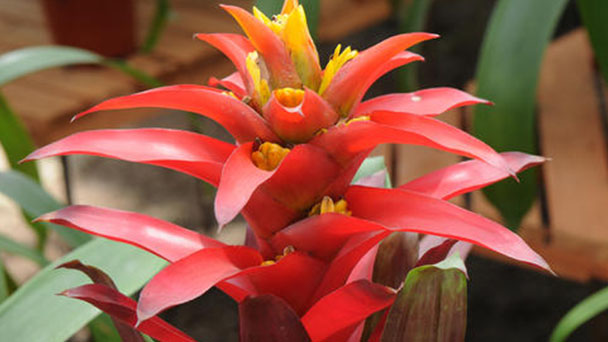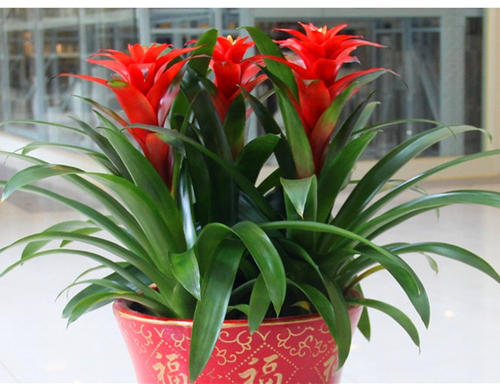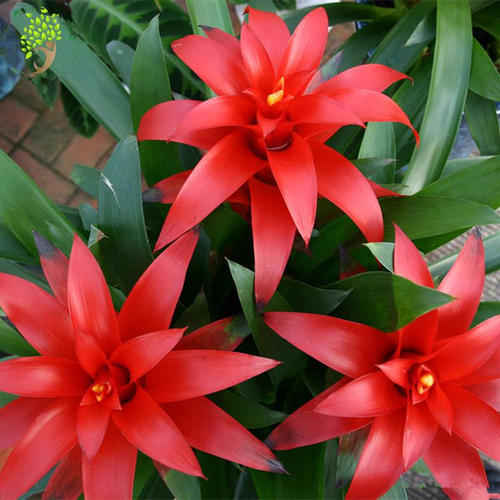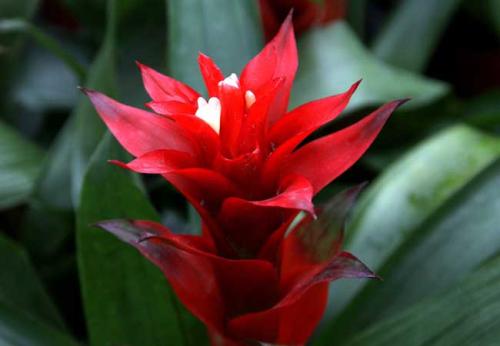Bromeliads profile
Written by Maggie
Sep 09 2021

Bromeliads belong to the genus Bromeliads. They are native to the jungles from Mexico to southern Brazil and northern Argentina. There are about 50 species of Bromeliads, most of which are native to the ground. Leaves are sickle-shaped, the upper part of the downward sloping, in 5 to 8 pieces arranged into tubular rosettes.
Bromeliads are today's most popular indoor foliage plants, with peculiar flowers, beautiful pattern, make people tut-tut-tut-surprised.
Bromeliads picture

Morphological characteristics of Bromeliads
The leaves of Bromeliads are long and narrow like swords, green and shiny. Winter to early spring, from the pale green leaf tube out bright red columnar, about 30 cm high; The terminal has 6-12 small flowers, 3 petals, pale yellowish green, blue margin, open and curling outward. In full bloom, clusters of blue-green flowers, set off by red bracts, are showy and dazzling, and may be viewed for up to two months.
The leaves of Bromeliads are basal rosette, hard leathery, banded and curved. Some leaves have dark green horizontal stripes, some brown leaves have green splash patterns, and some green leaves have dark green spots. Especially near the flowering stage, the central part of the leaf becomes bright deep red or pink, or the whole leaf is deep red, or only the front is red. Leaf margin is finely toothed, leaf tip spiny. The flowers are mostly sky blue or lavender red.
The ecological habits of Bromeliads
Bromeliads are very suitable for interior decoration. They are fond of at least 3 hours of sunlight per day, but can also withstand semi-shade. In summer, they are fond of cool, ventilated and dry weather.The soil should contain the acid sandy soil with rich humus and good water spraying and drainage.

Bromeliad - Most Common House Plant
Growing management and propagation of Bromeliads
Bromeliads are extremely easy to care for, as long as you master their preference for heat, moisture, and shade, and can be kept indoors in a warm, bright environment all year round. Winter can be full sunshine, spring and autumn morning and evening should have light, summer does not direct sunlight. The light is bright and the leaves are bright in color. The overwintering temperature should not be lower than 10℃, but higher than 20℃ is not conducive to plant dormancy, which will affect the growth and sweat flower of the next year.
From late spring to the growing season of autumn, it can be appropriate to increase the amount of watering, leaf cylinders can also fill some clear water, and you need half a month for water, so as not to water metamorphism stinks. Spray foliar water often. Winter basin on some of the appropriate, but should not be too dry. From May to September, nitrogen fertilizer was applied once a week, and phosphorus and potash fertilizer were applied appropriately before flowering to promote large flowers and colorful flowers. When flowering, do not fill the tube with water, stored in a dark place, which can prolong the flowering period. After flowering into the dormant period, the pedicel must be cut off to reduce the consumption of nutrients. Do not fill the cylinder with water in winter.
Bromeliads grow better in small and shallow pots than in large and deep ones because they don't have very developed roots, and some of them like to be exposed to air. The basin soil had better add a small amount of garden soil with leaf rot, or mixed with peat and perlite.
After flowering, the central leaf cluster dies and the subsidiary plants continue to grow. When the seed plant is 15 cm high, it can be taken down from the mother plant with roots. In this way, only "generation only", the number of reproductions is limited. Therefore, it is best to combine with the spring repot, cut the mother tuber part of the small tuber cuttage, or with the root germination of the old plant roots of the long roots of the tender bud seedling, to avoid shade moisture preservation. When the root system is long to 2-3 cm, you can be transplanted. If cultivated correctly, a mother pearl can produce about 10 plants per year.
Garden use of Bromeliads
Bromeliads are ornamental plants with strong flower and leaf values. They can be cultivated indoors and are of high taste for home gardening.
The Bromeliads flower language
Bromeliads flower language is perfection.

Latest Updated
- Benefits of Bugleweed - 7 Science-backed Health Benefits
- Bugleweed Dangers & Side Effects - Is It Poisonous?
- How to Plant Evergreen Trees - What You Should Know
- When to Plant Evergreens - Grow Guide for Evergreen Trees
- 12 Wonderful Evergreen Shrubs for Your Garden
- 12 Popular Evergreen Plants with Pictures for Beginners
- When And How To Prune A Lilac Bush Like a Pro
- How to Grow & Care for Lilac Vine (Hardenbergia Violacea)
- Japanese Lilac Tree (Syringa Reticulata) Care & Propagation Guide
- Shumard Oak Pros and Cons - What to Know
Popular Articles
- Winter maintenance of Antirrhinum Majus
- How to Grow Terminalia Mantaly Tree
- How to Grow and Care for Crossostephium Chinense
- How to grow Antirrhinum Majus in spring
- Peristeria Elata (Dove Orchid) Profile: Info & Care Guide
- Underwatered Snake Plant (Sansevieria Trifasciata) - Signs And How To Fix
- How to Care for Brazilian Jasmine Plant (Mandevilla Sanderi)
- How to Grow & Care for Graptopetalum Purple Delight in Summer
- Rosa Chinensis (China Rose): Plant Growing & Care Tips
- How to Care for Baby Sun Rose (Aptenia Cordifolia)